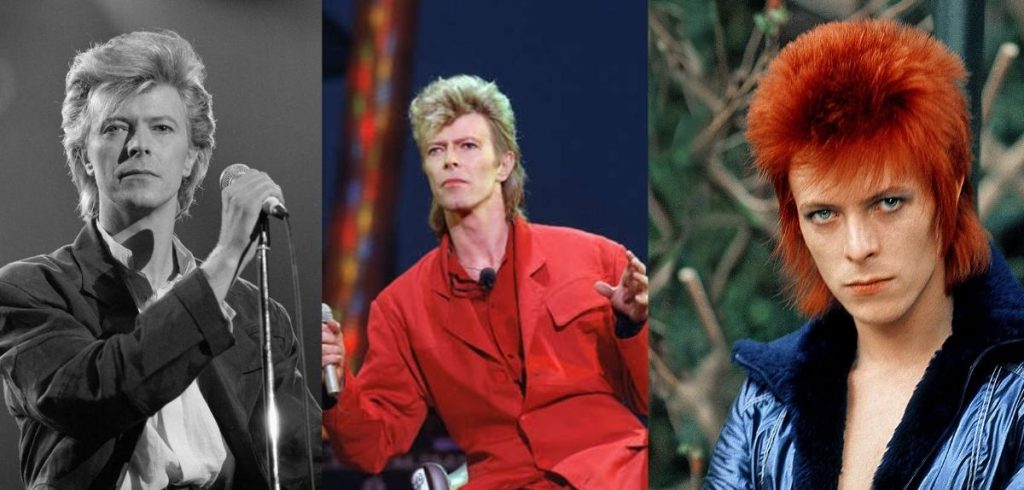When you think of 1970s rock rebellion, few images are as unforgettable as David Bowie’s fiery red mullet. It wasn’t just a haircut — it was a statement. The look captured everything Bowie stood for: fearless individuality, gender fluidity, and a flair for the dramatic. His mullet blurred lines between glam and grit, setting the stage for fashion revolutions that would echo through decades.
Before the mullet came to life, Bowie had already been experimenting with hair — from the mod-inspired bobs of the ‘60s to the edgy shags that hinted at his Ziggy Stardust transformation. But it was the Ziggy-era mullet that truly became his signature, merging futuristic androgyny with rock star excess. This bold evolution wasn’t accidental; it reflected his shift from the glam rock theatrics of Ziggy Stardust to the soulful sophistication of Young Americans.
In this guide, we’ll explore how Bowie’s mullet evolved, why it became a global phenomenon, and how you can recreate this timeless symbol of self-expression.
Historical Context: Bowie’s Mullet Evolution
Pre-Mullet Era (1960s–Early 1970s)
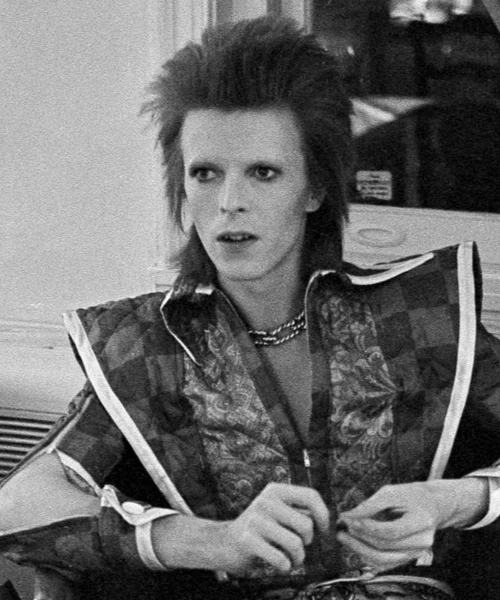
In the early years, David Bowie’s hair mirrored Britain’s swinging mod scene — neat, shaggy bobs inspired by artists like The Kinks and The Beatles. As the ‘70s began, his style grew bolder. During the Ziggy Stardust era (1972), Bowie unveiled a bright orange, spiked proto-mullet designed by his stylist Suzi Fussey. It framed his face like flames — part alien, part rock god — and perfectly matched his theatrical persona.
The Classic Mullet Phase (1974–1976)
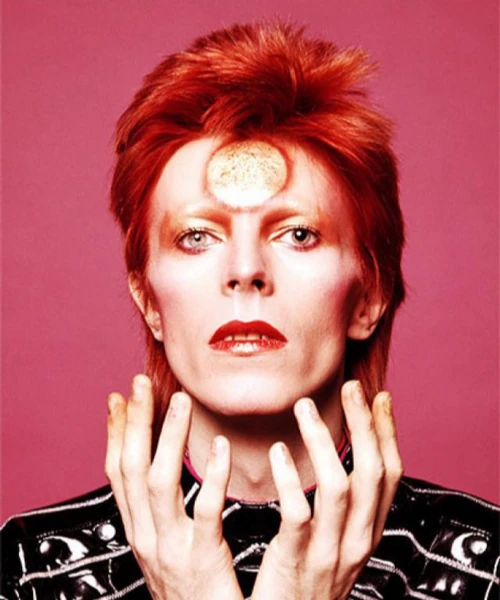
By 1974, the Ziggy red gave way to a softer, feathered Diamond Dogs-era mullet — longer, shaggier, and more refined. On the Young Americans tour in 1975, he debuted a sleeker, voluminous version inspired by Philadelphia soul, dyed golden-blond and styled with heavy layering. Finally, in Station to Station (1976), Bowie evolved into the “Thin White Duke” — with a bleached, sculpted mullet that looked almost architectural, reflecting his shift toward minimalist sophistication.
Post-Mullet Era (Late 1970s Onward)
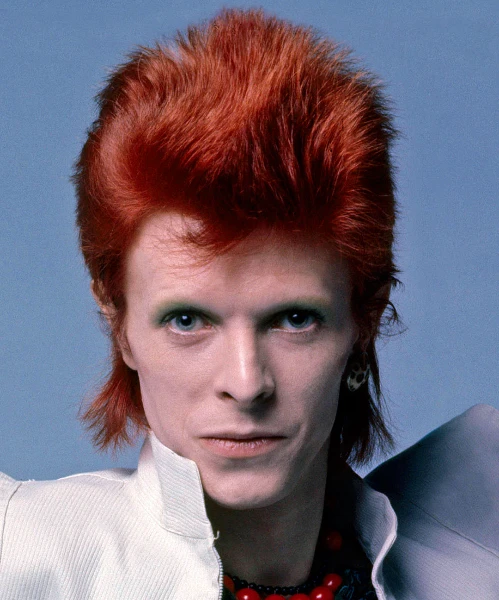
After retiring Ziggy and the Duke, Bowie traded his mullet for cropped, asymmetrical cuts throughout his Berlin Trilogy years (1977–1979). Still, the silhouette of the mullet — short front, long back — lingered in softer forms during the Let’s Dance era of the 1980s. Even decades later, echoes of that iconic shape continued to influence artists, from 1990s Britpop stars to modern trendsetters like Harry Styles.
Cultural Impact and Significance
Rock ’n’ Roll Revolution
David Bowie’s mullet wasn’t just a hairstyle — it was a rebellion wrapped in glitter. When he first appeared as Ziggy Stardust in 1972, that flaming red cut became a symbol of a new kind of masculinity — one that didn’t play by old rules. It blurred lines between male and female aesthetics, giving permission for self-expression that felt alien, glamorous, and defiant all at once.
Music journalist Simon Reynolds once noted in The Guardian that Bowie’s Ziggy-era look “gave people permission to be whoever they wanted to be — sequins, feathers, and all.” His mullet helped reshape glam rock’s identity, inspiring everyone from Billy Idol to Joey Ramone to experiment with androgyny and edge. It became more than fashion — it was a cultural awakening.
Pop Culture Legacy
The Bowie mullet quickly transcended music. By the late ‘70s and early ‘80s, it had made its way into film, art, and even animation. Movies like Velvet Goldmine paid direct tribute to Bowie’s Ziggy persona, while The Simpsons featured tongue-in-cheek nods to his ever-changing hairstyles. Fast forward to the digital age, and the phrase “business in the front, party in the back” became internet shorthand for the very duality Bowie embodied.
In 2022, when the Ziggy Stardust and the Spiders from Mars documentary was rereleased, Google Trends showed a 300% spike in searches for “Bowie mullet.” It proved that even half a century later, people still see that haircut as the ultimate mix of art, freedom, and attitude.
Fashion and Gender Norms
Bowie’s haircut cracked open the door for gender-fluid fashion long before it was mainstream. In the macho rock scene of the 1970s, his orange mullet and makeup were revolutionary acts. According to Vogue UK, Bowie’s look “made it acceptable — even desirable — for men to embrace softness, color, and flair.”
This influence is still visible today. Designers like Gucci’s Alessandro Michele have cited Bowie as a muse, often referencing the glam rock silhouette in modern collections. The mullet has found new life among Gen-Z audiences, who see it not as a joke, but as a powerful emblem of individuality and nostalgia.
Step-by-Step Styling Guide: Recreate the Bowie Mullet
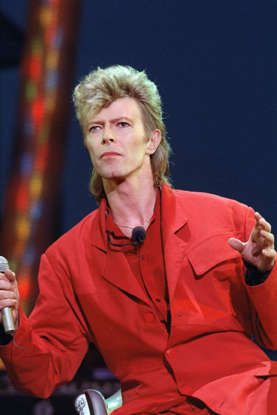
Want to channel your inner Ziggy Stardust? Here’s how to bring back Bowie’s iconic mullet — modernized for today’s look but with that same glam-rock edge.
Tools and Products You’ll Need
Before starting, make sure you’ve got these essentials on hand:
- Round brush – to shape the layers and create lift at the crown.
- Hair dryer – preferably with a concentrator nozzle for controlled volume.
- Texturizing spray or mousse – to add light grip and hold.
- Gel or pomade – for sculpting definition, especially around the fringe.
- Light-hold hairspray – to finish with a soft, natural sheen.
Haircut Instructions (For Medium-Long Hair)
- Base Cut – Ask your stylist for a medium-length shag with layered back and shorter front sections. The top should be around 4–6 inches, while the back extends to 8–10 inches.
- Taper the Sides – Keep the sides soft and feathered; this helps the look flow naturally rather than appearing blocky.
- Add Texture – Use thinning shears or a razor to create those wispy, lived-in ends — Bowie’s signature detail.
- Blow-Dry Forward – Dry the top layers toward your forehead, teasing the crown for lift.
- Style and Set – Apply gel or pomade through your fingers, scrunching for texture. Finish with a mist of hairspray to lock it in.
Variations of the Bowie Mullet
- Ziggy Stardust (1972) – Fiery red dye, spiked crown, and sharp edges.
- Diamond Dogs (1974) – Shaggy, layered flow with a natural reddish tone.
- Young Americans (1975) – Smooth, feathered blond mullet with soul-inspired volume.
- Modern Revival – Asymmetrical cut with a shadow undercut for a sleek, wearable twist.
Pro tip: Bring a photo reference — like Bowie’s “Young Americans” cover — to your stylist. It ensures they nail the balance between artful and effortless.
Modern Revivals and Celebrity Tributes
The 2020s Mullet Renaissance
After decades of being teased as the “dad haircut gone wrong,” the mullet is back — and it owes a big nod to Bowie. During the post-lockdown style reset, searches for “modern mullet” jumped by 150% on Google Trends, as people embraced DIY haircuts that felt bold and nostalgic. Bowie’s influence was written all over it: textured layers, volume at the crown, and that effortless edge that said, “I don’t follow rules — I make them.”
From TikTok to fashion runways, #BowieMullet has gained millions of views. Stylists on Instagram often call it the “gateway mullet,” because it blends retro glam with modern wearability — a look anyone can pull off with confidence.
Celebrity Examples
Bowie’s spirit continues to echo through the stars. Harry Styles brought a soft, shaggy version to life in his Fine Line era, pairing it with vintage suits and pearls. Timothée Chalamet, during the Wonka (2023) press tour, wore a tousled, asymmetrical cut that subtly nodded to Bowie’s Young Americans look. Even Billie Eilish flipped the concept — wearing a gender-fluid, platinum-blond mullet that redefined androgyny for Gen Z.
Each of these revivals pays tribute not just to a hairstyle but to Bowie’s larger message: fashion and identity are playgrounds, not prisons.
DIY vs. Professional Styling
If you’re ready to try the look, you’ve got two routes:
- At-Home Experiment: With a few tools and a steady hand, you can craft a soft version for around £40–£50 using basic layering scissors and styling products.
- Salon Upgrade: For a precise, photo-ready Bowie transformation, expect to spend £100–£150 at a skilled stylist who understands layered geometry and vintage volume.
Tip: Bring references from Bowie’s Diamond Dogs or Young Americans eras — stylists familiar with these cuts will know exactly how to modernize them for your hair texture.
Common Questions About Bowie’s Mullet
Was David Bowie’s mullet natural?
Not at all. Bowie’s vibrant red Ziggy-era mullet was the result of weekly perms and dyes, handled by his longtime stylist Suzi Fussey. She famously used drugstore peroxide mixed with red toner to create that otherworldly flame hue that became his trademark.
Which products work best for volume and texture?
If you’re chasing that classic lift and separation, stylists recommend Ouai Texturizing Spray or Bumble and Bumble Thickening Mousse. Bowie’s 1970s hair was all about lift — not stiffness — so aim for a lightweight hold that moves with you.
What face shapes suit the Bowie mullet best?
Oval and heart-shaped faces wear it effortlessly, but if you’ve got a square jawline, just add a soft fringe or longer crown to balance out the structure.
Fun Facts
- Bowie’s Diamond Dogs-era mullet was styled by Teddy Antony, who described it as “part rock, part alien, part aristocrat.”
- Despite popular belief, the term mullet wasn’t coined until the 1990s, but Bowie’s version in the 1970s became its spiritual origin.
- In 2024, Bowie’s Ziggy Stardust look — complete with his mullet — was featured in the Museum of Modern Art’s “Icons of Style” exhibition.
- His hair changes were so frequent that Rolling Stone once joked he “could start a new era just by visiting the salon.”
Bowie’s mullet remains more than just a nostalgic throwback — it’s a reminder that boldness never goes out of fashion.
Conclusion
From the glitter-drenched stages of the 1970s to the TikTok feeds of 2025, David Bowie’s mullet has defied every trend cycle. It wasn’t just a haircut — it was a declaration of freedom, creativity, and rebellion. Bowie didn’t wear his mullet to fit in; he wore it to stand out, and in doing so, he redefined what style could mean.
Today’s modern versions — whether on pop stars, actors, or fans rediscovering glam rock — still carry that spark of individuality Bowie championed. The lesson? A great haircut isn’t just about how it looks, but how it makes you feel — bold, unapologetic, and entirely yourself.
So if you’re tempted to go for it, book that appointment, grab your texturizing spray, and embrace your inner starman. Because trends fade, but Bowie’s mullet? That’s forever.

